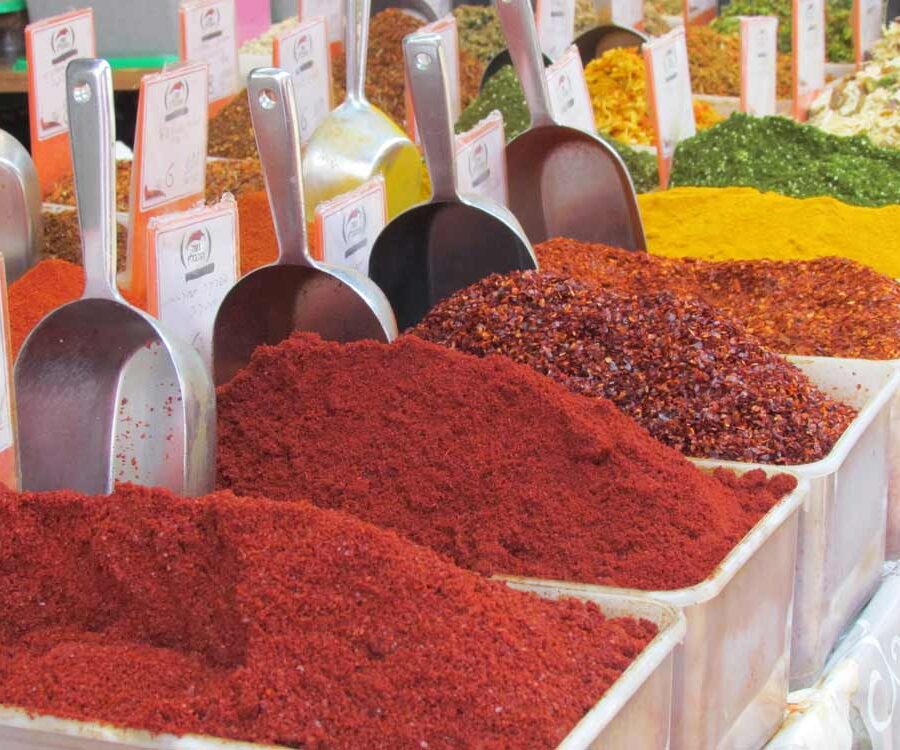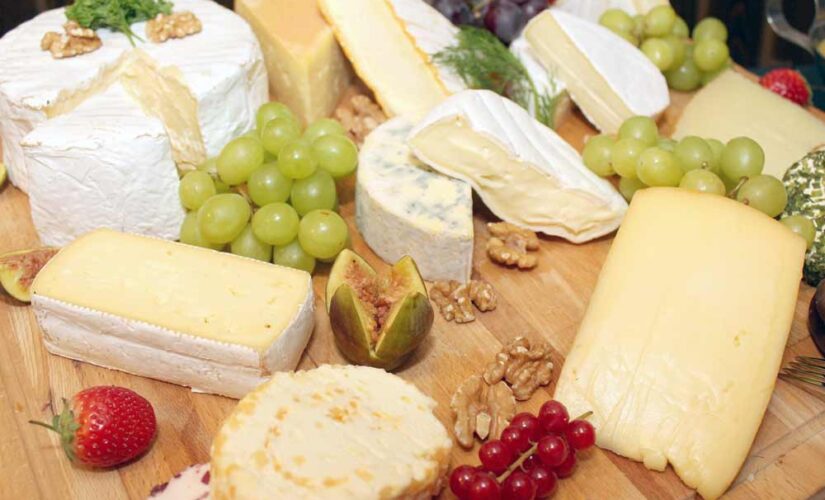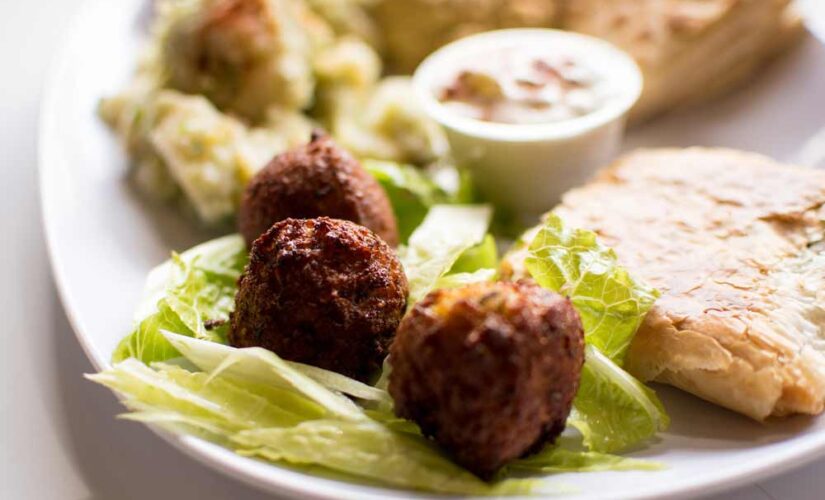Yes, the fall colors in the US and Canada are lovely...until it gets really cold…
#40 Live in a “foodie” wonderland

Israeli cuisine comprises both local dishes and dishes brought to Israel by Jews from the Diaspora. Since before the establishment of the State of Israel in 1948, and particularly since the late 1970s, an Israeli Jewish fusion cuisine has developed.
Israeli cuisine has adopted, and continues to adapt, elements of various styles of Arab cuisine and diaspora Jewish cuisine, particularly the Mizrahi, Sephardic and Ashkenazi styles of cooking. It incorporates many foods traditionally included in other Middle Eastern and Mediterranean cuisines, so that spices like za’atar and foods such as falafel, hummus, msabbha, shaksouka and couscous are now widely popular in Israel.
Other influences on the cuisine are the availability of foods common to the Mediterranean region, especially certain kinds of fruits and vegetables, dairy products and fish; the tradition of keeping kosher; and food customs and traditions specific to Shabbat and different Jewish holidays, such as challah, jachnun, malawach, gefilte fish, hamin, me’orav yerushalmi and sufganiyot.
New dishes based on agricultural products such as oranges, avocados, dairy products and fish, and others based on world trends have been introduced over the years, and chefs trained abroad have brought in elements of other international cuisines.
Israel’s culinary traditions comprise foods and cooking methods that span 3000 years of history. Over that time, these traditions have been shaped by influences from Asia, Africa and Europe, and religious and ethnic influences have resulted in a culinary melting pot. Biblical and archaeological records provide insight into the culinary life of the region as far back as 1000 years BCE, in the days of the kings of ancient Israel.
During the Second Temple period (516 BCE–70 CE), Hellenistic and Roman culture heavily influenced cuisine, particularly of the priests and aristocracy of Jerusalem. Elaborate meals were served that included piquant entrées and alcoholic drinks, fish, beef, meat, pickled and fresh vegetables, olives, and tart or sweet fruits.
The food of the ancient Israelites was based on several products that still play important roles in modern Israeli cuisine. These were known as the seven species: olives, figs, dates, pomegranates, wheat, barley and grapes. The diet, based on locally grown produce, was enhanced by imported spices, readily available due to the country’s position at the crossroads of east–west trade routes.
After the destruction of the Second Temple and the exile of the majority of Jews from the Land of Israel, Jewish cuisine continued to develop in the many countries where Jewish communities have existed since Late Antiquity, influenced by the economics, agriculture, and culinary traditions of those countries.
Old Yishuv
The Old Yishuv was the Jewish community that lived in Ottoman Syria prior to the Aliyah from the diaspora that began in 1881. The cooking style of the community was Sephardi cuisine, which developed among the Jews of Spain before their expulsion in 1492, and in the areas to which they migrated thereafter, particularly the Balkans and Ottoman Empire. Sephardim and Ashkenazim also established communities in the Old Yishuv. Particularly in Jerusalem, they continued to develop their culinary style, influenced by Ottoman cuisine, creating a style that became known as Jerusalem Sephardi cuisine. This cuisine included pies like sambousak, pastels and burekas, vegetable gratins and stuffed vegetables, and rice and bulgur pilafs, which are now considered to be Jerusalem classics.
Groups of Hasidic Jews from Eastern Europe also began establishing communities in the late 18th century, and brought with them their traditional Ashkenazi cuisine, developing, however, distinct local variations, notably a peppery, caramelized noodle pudding known as kugel yerushalmi.
Jewish immigration
Beginning with the First Aliyah in 1881, Jews began immigrating to the area from Yemen and Eastern Europe in larger numbers, particularly from Poland and Russia. These Zionist pioneers were motivated both ideologically and by the Mediterranean climate to reject the Ashkenazi cooking styles they had grown up with, and adapt by using local produce, especially vegetables such as zucchini, peppers, eggplant, artichoke and chickpeas. The first Hebrew cookbook, written by Erna Meyer, and published in the early 1930s by the Palestine Federation of the Women’s International Zionist Organization, exhorted cooks to use Mediterranean herbs and Middle-Eastern spices and local vegetables in their cooking. The bread, olives, cheese and raw vegetables they adopted became the basis for the kibbutz breakfast, which in more abundant forms is served in Israeli hotels, and in various forms in most Israeli homes today.
Early years of the State
The State of Israel faced enormous military and economic challenges in its early years, and the period from 1948 to 1958 was a time of food rationing and austerity, known as tzena. In this decade, over one million Jewish immigrants, mainly from Arab countries, but also including European Holocaust survivors, inundated the new state. They arrived when only basic foods were available and ethnic dishes had to be modified with a range of mock or simulated foods, such as chopped “liver” from eggplant, and turkey as a substitute for veal schnitzel for Ashkenazim, kubbeh made from frozen fish instead of ground meat for Iraqi Jews, and turkey in place of the lamb kebabs of the Mizrahi Jews. These adaptations remain a legacy of that time.
Substitutes, such as the wheat-based rice substitute, ptitim, were introduced, and versatile vegetables such as eggplant were used as alternatives to meat. Additional flavor and nutrition were provided from inexpensive canned tomato paste and puree, hummus, tahina, and mayonnaise in tubes. The meat was scarce, and it was not until the late 1950s that herds of beef cattle were introduced into the agricultural economy.
Khubeza, a local variety of the mallow plant, became an important food source during the War of Independence. During the siege of Jerusalem, when convoys of food could not reach the city, Jerusalemites went out to the fields to pick khubeza leaves, which are high in iron and vitamins. The Jerusalem radio station, Kol Hamagen, broadcast instructions for cooking it that were picked up in Jordan convinced the Arabs that the Jews were dying of starvation and victory was at hand. In the past decade, food writers in Israel have encouraged the population to prepare khubeza on Israel Independence Day. Local chefs have begun to serve khubeza and other wild plants gathered from the fields in upscale restaurants. The dish from the Independence war is called ktzitzot khubeza and is still eaten by Israelis today.
Impact of immigration
Immigrants to Israel have introduced elements of the cuisines of the cultures and countries from whence they came. In the nearly 50 years before 1948, there were successive waves of immigration, which brought a whole range of foods and cooking styles. Immigrants arriving from central Europe brought foods such as schnitzel and strudels, while Russian Jews brought borscht and herring dishes, such as schmaltz herring and vorschmack (gehakte herring).
Ashkenazi dishes include chicken soup, schnitzel, lox, chopped liver, gefilte fish, knishes, kishka and kugel. The first Israeli patisseries were opened by Ashkenazi Jews, who popularized cakes and pastries from central and Eastern Europe, such as yeast cakes (babka), nut spirals (schnecken), chocolate rolls and layered pastries. After 1948, the greatest impact came from the large migration of Jews from Turkey, Iraq, Kurdistan and Yemen, and Mizrahi Jews from North Africa, particularly Morocco. Typically, the staff of army kitchens, schools, hospitals, hotels and restaurant kitchens has consisted of Mizrahi, Kurdish and Yemenite Jews, and this has had an influence on the cooking fashions and ingredients of the country.
Mizrahi cuisine, the cuisine of Jews from North Africa, features grilled meats, sweet and savory puff pastries, rice dishes, stuffed vegetables, pita breads and salads, and shares many similarities with Arab cuisine. Other North African dishes popular in Israel include couscous, shakshouka, matbucha, carrot salad and chraime (slices of fish cooked in a spicy tomato sauce).
Sephardic dishes, with Balkan and Turkish influences incorporated in Israeli cuisine include burekas, yogurt and taramosalata. Yemenite Jewish foods include jachnun, malawach, skhug and kubane. Iraqi dishes popular in Israel include amba, various types of kubba, stuffed vegetables (mhasha), kebab, sambusac, sabich and pickled vegetables (hamutzim).
Modern trends
As Israeli agriculture developed and new kinds of fruits and vegetables appeared on the market, cooks and chefs began to experiment and devise new dishes with them. They also began using “biblical” ingredients such as honey, figs, and pomegranates, and indigenous foods such as prickly pears (tzabar) and chickpeas. Since the late 1970s, there has been an increased interest in international cuisine, cooking with wine and herbs, and vegetarianism.
A more sophisticated food culture in Israel began to develop when cookbooks, such as From the Kitchen with Love by Ruth Sirkis, published in 1974, introduced international cooking trends, and together with the opening of restaurants serving cuisines such as Chinese, Italian and French, encouraged more dining out.
The 1980s were a formative decade: the increased optimism after the signing of the peace treaty with Egypt in 1979, the economic recovery of the mid-1980s and the increasing travel abroad by average citizens were factors contributing to a greater interest in food and wine. In addition, high-quality, locally produced ingredients became increasingly available. For example, privately owned dairies began to produce handmade cheeses from goat, sheep and cow’s milk, which quickly became very popular both among chefs and the general public. In 1983, the Golan Heights Winery was the first of many new Israeli winemakers to help transform tastes with their production of world-class, semi-dry and dry wines. New attention was paid to the making of handmade breads and the production of high quality olive oil. The successful development of aquaculture ensured a steady supply of fresh fish, and the agricultural revolution in Israel led to an overwhelming choice and quality of fresh fruit, vegetables and herbs.
Ethnic heritage cooking, both Sephardic and Ashkenazi, has made a comeback with the growing acceptance of the heterogeneous society. Apart from home cooking, many ethnic foods are now available in street markets, supermarkets and restaurants, or are served at weddings and bar mitzvahs, and people increasingly eat foods from ethnic backgrounds other than their own. Overlap and combinations of foods from different ethnic groups is becoming standard as a multi-ethnic food culture develops.
The 1990s saw an increasing interest in international cuisines. Sushi, in particular, has taken hold as a popular style for eating out and as an entrée for events. In restaurants, fusion cuisine, with the melding of classic cuisines such as French and Japanese with local ingredients has become widespread.
In the 2000s, the trend of “eating healthy” with an emphasis on organic and whole-grain foods has become prominent, and medical research has led many Israelis to re-embrace the Mediterranean diet, with its touted health benefits.



